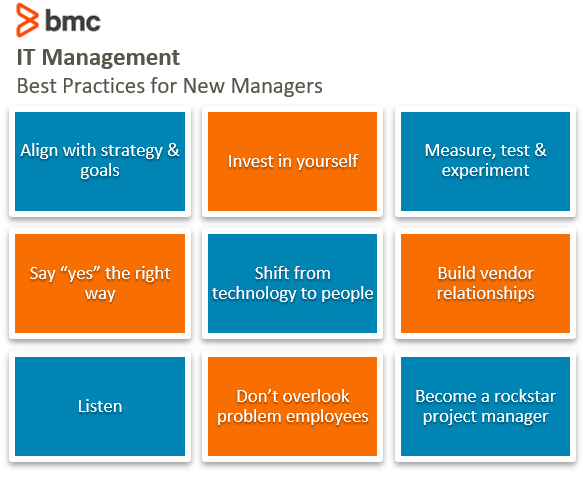Congratulations, you have been hired into your first IT Manager role! Now what?
Most people in IT management roles have come up through the ranks in one of the technical teams. Oftentimes, individuals with exceptionally strong technical skills eventually end up in an IT management role. However, the transition from technical staff to management is one of the toughest transitions for IT professionals.
To help new IT Managers, we asked two regular IT management Joes—Joe Roush and Joe Hertvik—to provide practical advice on making the change from tech professional to tech manager. Here’s what they said and how it can help you with your IT management journey.

Align with strategy & goals
Joe Roush: Aligning IT capabilities with organizational strategy and goals is probably the most difficult aspect of IT management. Instead of all your focus being on server capacity or quality code, you must now look at how those technical solutions benefit the organization. Senior leadership will expect this of you now as well. You’ll need to learn to:
- Speak in terms of organizational benefit
- Describe IT investments as improving organizational capabilities
Any good investment ask should answer:
- What your team has built/accomplished thus far
- What you need funding for
- What the funding will do and how long it will take to provide results (Be specific!)
- How needed and great the results will be
- Which people have already made an investment (For instance, the team members who’ve done research or previously worked with those tools can talk about how this helped a similar project.)
Joe Hertvik: Unless you’re running a one-man shop, stop being the best technician in the shop. Your new job isn’t programming apps, configuring the network infrastructure, or setting up servers. Your job is to organize, strategize, define, direct, and control IT software and hardware infrastructure to do two things:
- Enable, meet, and report on organizational goals using digital technology
- Create value for the business
Instead of being a rock star technician, you’ll be guiding, directing, and coaching rock star technicians to create organizational value. You’re now a member of the management staff responsible for IT resources. It’s a significant and important perspective shift, but it’s a critical shift that needs to be made.
Invest in yourself
Joe Roush: New managers often feel overwhelmed with their new responsibilities. The single most important thing you can do as a manager is continually invest in yourself. I have found that the best way to increase your (and your teams) productivity is to keep learning:
- Read management books.
- Seek out professional development opportunities.
- Get a mentor and become a mentee.
- Ask for funding to go to conferences.
- Even writing helps.
Joe Hertvik: I agree you should invest in yourself and get more training. Give priority to sharpening your management-oriented skills to supplement your technical skills. Take IT project management training. Learn budgeting, reporting, coaching, staff management, and leveraging IT for strategic advantage. Read IT management articles along with tech journals.
Learn more about your organization’s core business, its needs, and how digital technologies can help fulfill those needs. Take any management training your business offers, so you can speak in the business’s language.
You’re in the wheelhouse now, not the engine room. Learn wheelhouse skills.
Measure and test—but experiment, too
Joe Roush: One of the most important measures of performance for an engineer is server or application uptime. That is why we spend time analyzing changes and test before moving to production. But this doesn’t work when you’re managing people.
I’ve seen managers hesitate to have one-on-one meetings with team members because they “were still studying how to run an effective 1:1.” The only thing worse than a manager who makes bad decisions? A manager who makes no decisions.
As a manager, it’s OK to try things out. It’s OK to fail (small). You don’t have to analyze every aspect of a management concept before trying things out on your team. Learn along the way. Ask your staff for feedback, listen to their suggestions, and never stop experimenting.
Joe Hertvik: As for measuring, you’ll still have to do some of that. You can use basic Agile principles to address application/server uptime and communication issues, even if you are using Waterfall development. Agile principle 8 states:
Working software is the primary measure of progress.
Ensure your deployments are well-tested and ready to go. Create contingency plans to use in case of a deployment failure. This applies whether you’re implementing a single feature in a sprint or delivering a massive waterfall deployment.
Don’t be afraid to experiment, but recognize that experiments can fail and burn down the lab. Make decisions and learn along the way. Identify risks and plan what to do if a risk comes true (risk response planning). Coach your staff to plan for both opportunities and risks when implementing new technologies.
Say “yes” the right way
Joe Roush: No IT manager ever said, “I have enough resources to accomplish all of the goals of the organization.” However, you don’t want to be known as the IT manager who says no to projects all the time.
As a manager, you need to understand the capacity of your current team and be confident enough to ask for additional resources when it makes sense. Your business leadership won’t respond well to you turning down a project request if you say “No, I don’t have enough resources.” However, if you say, “That is a great opportunity for us, and I’m excited to get going. To be successful I’ll need an investment in…” This allows the business to agree that it’s worth the investment—or not.
Joe Hertvik: Let’s looks at project management to underscore Joe R’s point about asking for additional resources rather than just saying no to a new request. Project management training talks about the triple constraint, shown here:

Under the triple constraint:
- Scope is what you’re trying to do.
- Schedule is the time frame in which you’re doing it.
- Cost is the amount of money or resources needed to deliver results.
- Quality represents the desired outcomes you achieve.
Any change to one of the three constraints will affect the performance of the other two. Adding features to a project scope for example, will affect your project costs and schedule. It may also require new resources.
The triple constraint provides a great template for explaining what the effect of a request will be on other organizational goals and objects. If you analyze each request in terms of what it will do to existing projects scopes, schedule, or costs (including resources), management will have enough information to determine if the new project is worth the additional investment. You would have management buy-in for adding those new resources (or pushing the schedule or changing the scope) rather than just saying you don’t have the resources.
When presented with new business opportunities, talk in terms of how each opportunity affects their current commitment—then let management decide whether it’s worth the investment.
Transition from technology to people
Joe Roush: As a technologist, your value to the organization comes from your in-depth knowledge of all things technical in your field. The more you learn and grow your skills, the more valuable you become and the more technical responsibility you will be given. This all significantly changes when you become a manager.
As an IT manager, you are responsible for the results of whatever technical team or individual you are responsible for. No longer will acquiring new technical knowledge provide the benefit it once did. Instead, you must look at skills of the team, determine what is needed, and who is in the best position to acquire additional skills.
Joe Hertvik: Agreed. Take inventory of existing skill sets and knowledge. Know yourself and your team. Reevaluate that knowledge against what the organization needs you to do and determine how to fill in the gaps. This will allow you to successfully manage project and product implementations, including digital transformations.
Build vendor relationships
Joe Roush: This was a hard lesson for me to learn. I always kept my distance from vendors and had operated with a don’t call me, I’ll call you attitude.
Believe it or not, most vendors really do want to help you. There are always a few that are only interested in making a sale. However, most vendors truly believe that their solutions will help make your organization more successful:
- Let your vendors know what technology problems you’re struggling with.
- Listen to their solutions and make your own judgment call about their proposals.
- Sometimes they’ll get it wrong, but more often than not, your vendors can really help you out.
Vendors appreciate being partners with you also. If you only call them when you have a problem, they’ll do what they can to help (and probably maximize their profit). However, if they view your relationship as a partnership, they are often willing to grant favors when you are in a pinch. They are also more willing to let you have input on new products or participate in beta testing.
Joe Hertvik: The right vendors are your friends. It’s impossible for most shops to have all the technical skills needed to perform all tasks.
Inventory and introduce yourself as the manager to all current IT organizational vendors. Get to know them. Evaluate what they bring to the organization and understand why they are doing business with the company. Contract vendors function as supplemental staff, so establish a relationship—you’ll need them for upcoming projects.
Listen (The answer is in the room)
IT managers are responsible for delivering results—not having all the answers.
Joe Roush: As a technician or engineer, you are expected to have all the answers for the technology you support. Many new managers believe that they, too, must have all the answers. When this happens, new managers will feel overloaded and stressed out, and no one can manage or work well under those conditions.
Managers aren’t responsible for having all of the answers. They are responsible for delivering results. If you could come up with all the answers, you wouldn’t need staff. Leverage their knowledge. Ask them to solve problems. You’ll be less stressed out, and your team will see that you value their input.
Joe Hertvik: I’ll repeat myself here. Stop being the best technician/programmer/engineer in the shop. As a manager, you’re responsible for:
- Defining direction
- Delivering results
- Keeping your stakeholders happy
Guide and coach your staff to implement the solutions you need. Part of being a manager is developing the people who are under you. Sharing the burden strengthens the bench. You’re responsible for the final decision. Learn to lean on your staff (internal staff and external resources, like vendors) to get the answers you need.
Don’t overlook problem employees
Joe Roush: Troublesome employees can be devastating to teams. Just because the previous supervisor didn’t deal with poor performing staff, it doesn’t mean you should do the same. You got your management job because you were viewed as a leader, so don’t be afraid to lead.
However, for new managers, this is one of the most difficult things to do. New managers still building their confidence often ask whether the employee in question is truly a problem or all that bad.
My litmus test has always been, “Would I expect my boss to allow that from me?” If the answer is no, then it’s definitely time to deal with whatever is going on.
Joe Hertvik: Make friends with your HR people and understand what organizational procedures need to be followed when disciplining problem employees. You’re not on your own here, and you shouldn’t be.
Evaluating employee performance can come with significant organizational risk. To minimize the risk:
- Make sure any actions you take fall within company standards.
- You may not need to use the big stick when correcting bad behavior, but you need to understand how to use the little sticks and carrots to improve performance.
- Seek guidance.
Become a rockstar project manager
Joe Roush: No one ever received a giant bonus because they kept the lights on. New organizational benefits are delivered by IT to the organization through new projects—but they also bring large financial risk to the organization.
If you are known as the IT manager who delivers projects on time, within budget, with the desired outcomes, you will never have trouble getting what you need. Added bonus: your IT organization will be viewed as an asset to the organization rather than a liability or cost center that can be cut when times are tough.
Joe Hertvik: Remember what we’ve discussed above and put it into practice:
- Align yourself with your organizational goals and strategy.
- Invest in yourself through education and training.
- Experiment with new technologies and plan for opportunities and risk.
- Work with management as a business asset, not an IT asset.
- Speak and act to create business value.
- Learn how to deal with your employees and vendor partners fairly and effectively.
Do all this and you will become a rock star project manager!
Additional resources
For more on this topic, explore these resources:







